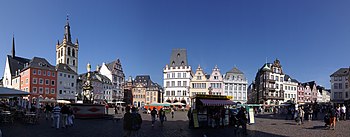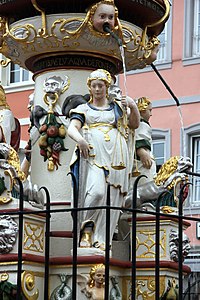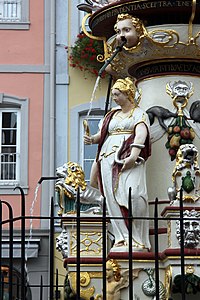Main market (Trier)
The main market of Trier is the central and one of the largest squares in the city.
It is located in the historic city center directly in front of the cathedral city in what is now the Mitte / Gartenfeld district . The main city shopping streets meet here. In 958 Archbishop Heinrich I decorated the main market with the market cross as a sovereign symbol . The main market in the medieval town was a place for selling goods and trading.
Two thirds of the market redevelopment with houses from the Renaissance , Baroque , Classicism and Late Historicism periods has been preserved. Today there are numerous large and representative buildings, including the Hauptwache and the former cathedral hotel in the neo-renaissance style of Germany. There you will also find the Steipe , a town house built around 1430 and (after complete destruction in World War II ) rebuilt in the 20th century with the help of “creative monument preservation” (Dehio) and today the house of the city council and the red house with the slogan about the legendary foundation Triers through Trebeta . The Church of St. Gangolf is only accessible from the market through a baroque gate and is otherwise completely renovated.
From the main market you can step through the Judenpforte into the Judengasse and get into the former Jewish quarter of the city.
Culture and sights
Market cross
Archbishop Heinrich I furnished the Hauptmarkt in 958 with the market cross as a national emblem . Above the leaf capital, it bears the Latin inscription "Henricus archiepiscopus Treverensis me erexit" (German: Archbishop Heinrich of Trier, Heinrich built me ) at a height of 3 m . The palmette- lotus- capital , which bears the market cross, was added in Carolingian times . On the front of the market cross there is an image of the Lamb of God with a cross staff and a victory banner. A representation of St. Peter and a sundial have been added to the sides of the market cross . The inscription “Renovatum 1724” is carved on the back.
Original market cross in the Simeonstift Municipal Museum
The cross stands on an old Roman column, which from 1200 also served as a pillory , which stood as a symbol for the market court . Even today four holes can be seen, to which chains with neck irons, shackles and shame stone were attached. Reports testify to allegedly two other pillories from the middle of the 14th century. How long the column was pillory has not been researched.
There is now only a copy of the medieval market cross on the pillar. The original, historically of great importance for the topography of the main market as a religious-political emblem and as a peace and legal symbol, has been exhibited in the Simeonstift Municipal Museum since 1964 . The Trier market cross is probably the oldest among the medieval market crosses in Europe, most of which have been preserved in Belgium and France .
The Marktkreuz has been at its current location since December 1, 1979. In 2004, it was painted again according to a color concept by Rainer Thelen.
Peter's fountain
The Petrusbrunnen, created in 1594/95 by the sculptor Hans Ruprecht Hoffmann , in the southern area of the square stands roughly at the intersection of Grabenstrasse and Dietrichstrasse . At the top there is a figure of the city patron Peter, who gave the fountain his name. The four cardinal virtues are grouped over a hexagonal basin, namely Justitia - justice, with sword and scales, Fortitudo - strength, with a broken column, Temperantia - moderation, with wine and water, and Sapientia - wisdom, with mirror and Snake. In between there are figures of virtue, putti, animals (geese, lions, dolphins, eagles, monkeys), the city arms and various decorative elements. The coat of arms of the Diocese of Trier (a red cross on silver) is also included, with the coat of arms of Bishop Johann VII von Schönenberg on it in the middle (three silver crosses on black). In addition to its decorative function, the fountain originally served as a water supply and was fed by the water pipe from the so-called Herrenbrünnchen. Only since the installation of a central water supply in Trier has it been a purely ornamental fountain.
- Peter's fountain
The fountain did not suffer any major damage during the Second World War, as it was protected in good time by masonry from fragments of bombs and shell fragments. In 1982/83 it was extensively renovated. Since only very little remains of the original painting could be found, a new color version was developed after comparing it with other works of art from the time the fountain was created. In 2004 the fountain was given a new coat of paint. Another thorough restoration was carried out in 2013/14, during which primarily damage to the stone material had to be removed, and then the color scheme was renewed again. The fountain technology also had to be completely replaced, and the fountain was given new lighting.
Every year at the beginning of the old town festival, the figure of St. Peter is lighted with a bouquet of flowers to ensure nice weather on the holidays.
More Attractions
- On the east side of the square there is a memorial plaque for Cläre Prem in the facade of the “Alte Hauptwache” .
- In a side street, behind the choir of St. Gangolf, there is a replica of one of the medieval pillories .
- Main market
Events
The following events take place every year on the main market:
- Street carnival (Women's Thursday and Rose Monday procession)
- Old town festival (this extends from the Porta Nigra in the north to the cattle market in the south) at the end of June
- Christmas market (including the nearby Domfreihof) in December
- New Years run
- Corpus Christi procession (with mass)
literature
- Patrick Ostermann (arrangement): City of Trier. Old town. (= Cultural monuments in Rhineland-Palatinate. Monument topography Federal Republic of Germany . Volume 17.1 ). Wernersche Verlagsgesellschaft, Worms 2001, ISBN 3-88462-171-8 .
- Georg Dehio, Hans Caspary (edit.): Handbook of German Art Monuments, Rhineland-Palatinate - Saarland . 2nd revised and expanded edition. Deutscher Kunstverlag, Munich 1984, ISBN 3-422-00382-7 .
Web links
- Trier main market - Interactive 360 ° panorama
Coordinates: 49 ° 45 ′ 24 " N , 6 ° 38 ′ 28" E














